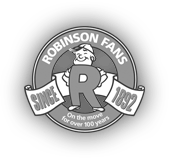INDUSTRIAL DAMPERS FOR HIGH-SPEED FAN EQUIPMENT
Robinson has provided fans and dampers for industry since 1892. In the early years, the company built equipment primarily for coal mine ventilation. In the 1930s, experience in high-temperature applications was acquired as a result of units built for brick-drying operations.
As its customer list has expanded to steel, cement, aluminum, pulp and paper, fertilizer, glass, chemical, coal preparation and utility industries, Robinson’s experience and expertise in building dampers have steadily increased. Input from Robinson’s field servicemen enables the company to handle the hot, dirty and corrosive jobs as well as high-efficiency, clean-air applications. Today, this experience is available to industry in the form of long-lasting, low-maintenance dampers.
Industrial Dampers are engineered for:
- Air performance control
- Power savings
- System isolation/shutdown
- High temp/dust-laden conditions
- Air dilution systems
- Low leakage applications
Engineering Design
Robinson’s staff of mechanical engineers uses the same technical expertise in the design of custom dampers that is so critical in the design of high-speed rotating fan equipment. Important design considerations include:
- Shaft deflection
- Torque requirements (for sizing actuator)
- Frame stiffness
- Bolt sizing and spacing
- Bearing selection
- Shaft seal design
- Low leakage seals (when required)
- Material selection
Correct damper design involves use of laboratory test data and years of field experience in addition to textbook engineering and computer-aided calculations.
Laboratory Testing
An AMCA-registered laboratory with prototype fans of nearly every design makes it possible for Robinson to carefully test damper designs. In addition to air performance characteristics and effects on fan performance, prototype testing of damper torque under load is also done at Robinson.
Test setups of new damper designs include cycling tests involving reliability of the actuator/linkage system. Leakage tests use AMCA design ducts for accurate volume measurement at various pressure drops.
Quality Assurance
Robinson’s quality assurance program was developed as a result of involvement with large public utilities over the years. In-house procedures for handling “critical” dimensions, welding fit-up, weld procedures, etc., are well established.
Nondestructive testing includes magnetic-particle and dye-penetrant inspection expertise as well as in-house X-raying of butt-welds . Hold points for customer witnessing and/or inspection can be set up if desired on critical jobs.
Critical path scheduling includes all such quality assurance procedures, which are integrated into the production schedule.
Product Types
Louvered Damper
- 15% leakage (typical).
- Special (1% leakage).
- Air-dilution type available.
- Parallel blade operation.
- Lower efficiency when dampered.
- Avoid if large percent run time at very low damper opening (high turn-down).
- Good for dirty air stream; no mechanism in air stream.
- Opposed blade available for fan outlet side (no HP savings).
- Synchronized operation for DWDI available.
Radial Damper
- Good dampered efficiency.
- Minimizes rotating stall.
- Supported center or cantilever design.
- Adds to complexity if there are inlet boxes involved.
- Good for open inlet, SWSI.
- 10-15% leakage (typical).
- Operating linkage outside air stream.
Vortex Damper
- Minimizes rotating stall.
- High efficiency in dampered condition.
- Mechanism outside air stream.
- Straight or conical inlet pieces can be used.
- 10-15% leakage (typical).
- Cannot be used without inlet box.
- No need to extend bearing centers for DWDI.
- Split design available.
- Synchronized operation for DWDI available.
- Operating linkage outside air stream.
Variable Inlet Vane (VIV)
- Built as a part of the inlet piece.
- High efficiency when dampered.
- Minimizes rotating stall.
- No need to extend bearing centers on DWDI (shaft goes through).
- Tapered boxes are possible.
- Mechanism in air stream.
- Requires cone-shaped inlet piece design.
- 10-15% leakage (typical).
Robinson Damper Repair and Rebuilding
Complex damper components are often repaired to “like-new” condition at a fraction of the cost of a new unit. Robinson’s experience in fan and damper repair provides an alternate solution to difficult problems.
When equipment fails in service, a plant slowdown or shutdown usually results. Robinson’s repair and rebuilding department emphasizes quick turnaround , completing and shipping first-quality repair jobs for on-time delivery. This priority commitment minimizes customer downtime and lost profits.
Primary Industries Served
- Steel
- Mining
- Cement
- Ceramic
- Chemical
- Woodworking
Typical Air-Moving Applications
- Building ventilation
- Fume removal
- Dust removal
- Dust collection
- Pneumatic conveying
- Oven and dryer exhaust
- Combustion air
- Incinerators
- Heat recovery






